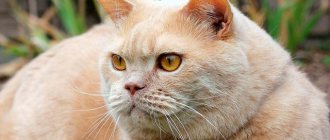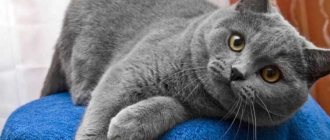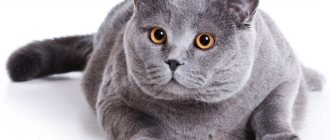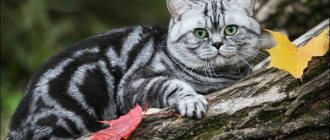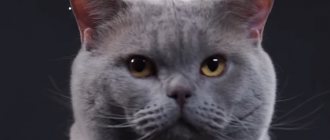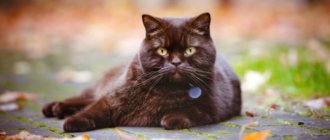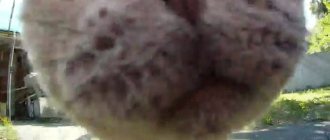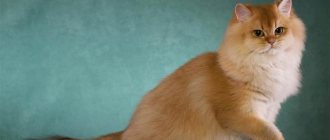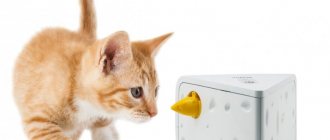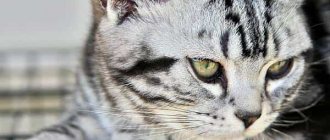The native English breed has an appearance that cannot be confused with other cats. As for amateurs, their knowledge is not as rich as that of experienced felinologists. Therefore, in order to distinguish a British cat from an ordinary street cat, you need to study the characteristics of this breed - its character traits and external signs.
Contents of a Black Briton
British cats are a fairly easy-to-care breed; if properly maintained, British cats can easily live up to 15-16 years of age without causing much trouble to the owner. Therefore, the key points that the cat owner should know are mainly related to the animal’s nutrition.
Feeding a British cat
The owner of the animal can choose two feeding options - natural food or a diet consisting of high-quality dry food. It is impossible to mix two types of diets, as this is fraught with gastrointestinal problems for your pet. If we talk about industrial ready-made food, then you need to choose the “super-premium” or “holistic” lines, if possible selecting the specific breed of food. Many brands offer food made and selected specifically for the British breed.
Royal Canin for British cats
However, modern food is not necessarily selected strictly for the breed - it is better to focus on the characteristics of the animal (homebody, castrated or sterilized animal, walking on the street, and so on). Each pack contains a table from which you can easily find out the daily dosage of food for a Briton - just weigh the animal and follow the manufacturer’s recommendations.
British cats are prone to obesity, so you should not overfeed your pet or leave food freely available.
An adult should be fed twice a day, morning and evening; the rest of the time there should be only clean, cool drinking water in the bowl - this is important!
To prevent your cat from suffering from excess weight, the serving size needs to be adjusted.
The natural nutrition of a British cat is based on fresh raw meat (turkey, veal, rabbit are preferred). There is no need to boil the meat, in which case it loses its beneficial properties, just pour boiling water over the piece before cutting and immediately offer it to the cat.
Food from the master's table is not suitable for the British; there is no need to cook porridge or soups for the cat - they negatively affect the digestive system of the predator. To raw meat you can add grated raw vegetables (pumpkin, carrots, zucchini), quail or chicken eggs, and finely chopped herbs. Every day a cat eating natural food should receive kefir or cottage cheese. You need to remember that in terms of the amount of protein, curd mass is equivalent to meat, and balance the diet based on this - an excess of protein “hits” the liver.
Fresh meat should occupy at least 60% of a small predator's bowl
In addition to meat, dairy products, vegetables and herbs, British cats should receive additional mineral and vitamin supplements - high-quality complex vitamins can be purchased at a pet pharmacy (Canina, 8 in 1, Beafar, Polidex).
British black cats benefit from adding a little kelp seaweed to their daily dose, which maintains and maintains the bright charcoal color of their coat. Dietary supplements for cats containing kelp are also sold in pet stores.
Treats with kelp for cats
Black British coat care
The short but thick coat of a British cat requires some attention from the owner - once a week the cat needs to be thoroughly combed with a slicker brush with droplets on the tips of the teeth or with a special massager. During the molting period, grooming procedures should be carried out more often - once every two days, carefully combing out the dead undercoat. A kitten must be taught to brush itself from a very early age, otherwise a wayward adult cat may resist.
British cats are washed once every six months, or when soiled, if the animal has access to the street or spends the summer season outdoors. For washing, special shampoo for animals should be used. For black Britons, we recommend lines of cosmetics designed specifically for dark coats: “Royal Groom Black Pearl”, “Ring 5 – Black Out”, “Kiss Black Bagheera” and the like.
The British are clean and do not need to be bathed often
General Content Rules
Like any cat, the British cat must regularly undergo the following procedures: annual vaccination and quarterly deworming treatment. If your pet has access to the street, during the spring-autumn season you need to treat it against ticks and also wear a flea collar. Also, cats walking outside should have a separate thin collar on which will hang a tag with the owner’s phone number.
Cats must be vaccinated
Features of white British cats
White British people are wonderful, amazing and unique. But maintaining the image of an ideal cat is not as easy as it might seem.
You will have to look after a white cat like a small child.
Fur coat maintenance and care
For everyday care of white fur, it is better to choose cosmetics with a natural composition. Such products (shampoos, sprays, powders, etc.) are not cheap, but they do not damage the fur or irritate the skin, which in white cats is very sensitive and prone to allergies.
Preparations for the care of teeth, ears and eyes should also be used with caution. British Shorthairs do not have eyelashes, so their eyes require extra attention. Just do not wash them with tea leaves - it will leave stains on the white fur that cannot be removed.
A dirty white cat is a sad sight
Try not to bathe your cat with shampoos too often - washing once every three months is optimal. In between bath procedures, you can keep your white coat clean using dry cleaning products or special sanitary napkins. And, of course, do not forget about normal hygiene - regular combing (weekly for short hair and two or three times a week for long hair, especially during the molting period).
The delicate pink skin of white British dogs is very sensitive to weather conditions, insect bites, and chemicals.
When feeding a natural diet, do not use foods that can stain the white coat, such as beets or carrots. It is not recommended to overfeed British cats - these cats have a tendency to become obese.
Breeding
Purposeful breeding of snow-white British cats is not an easy task, and it is only accessible to experienced breeders. Especially when the goal of breeding work is to obtain not only beautiful, but also healthy offspring. The main reason for breeding difficulties lies in an interesting genetic phenomenon - epistasis. Its essence is that genes, interacting, are able to influence each other, and one of them can suppress the others. This is exactly what happens in cats, when the W gene responsible for white color overrides the action of all other “color” genes. Relatively speaking, the cat seems to be wearing a kind of camouflage white robe, under which its true colors are hidden.
The birth of white British kittens is always a holiday
If you do not thoroughly know the pedigree of your white beauty, you will never be able to guess even approximately what kind of kittens she will give you. In order to somehow predict the colors of their fur coats, you need to have information about the colors of their ancestors in several generations, or find out the potential of a white cat in practice by analyzing its litters from different cats.
The difficulty of obtaining white offspring also lies in the fact that it is impossible to select both white sires - the risk of giving birth to deaf kittens is too great, and congenital defects of vision or smell may also occur.
Participation in exhibitions
Preparing for white British cat shows is a difficult, but very interesting process. Such cats, especially short-haired ones, always look great at cat shows, but only their owners know how much work it takes. Experts are demanding about the quality and condition of the fur of such animals: ten points out of a possible hundred are allocated for this aspect.
With equal breed potential, the cat whose fur will be better prepared for the exhibition will win. The white color of a cat's coat should be ideal: a cool shade, without the slightest hint of yellowness - it is especially important to get rid of the spots that form on the bottom of the paws, under the tail and on the face of a white British cat.
Conventional white coat care products are usually not enough. Special exhibition cosmetics are needed, including for lightening problem areas. But it is aggressive in its composition, so it should be washed off immediately after the exhibition.
If you want your cat to become a champion, you will have to try hard
Important breed nuances
The most common anomaly of white blue-eyed cats of all breeds is deafness. Even a cat with different eyes may not hear in the ear located on the side of the blue eye. This often happens, but not always - scientists say that only a third of blue-eyed British cats are born deaf. To avoid perpetuating the problem in the offspring, deaf animals are excluded from breeding, and mating white cats with white cats, as we already know, is strongly discouraged.
Blue eyes in a white cat are an ambiguous sign of deafness
Precisely because the pedigrees of white offspring may contain ancestors of very different colors, newborn kittens quite often display dark spots or stripes, most often on the head. This is not a defect, but an age-related feature - by about a year the color should even out and become pure white.
Judging by the stripes on its head, the white kitten had blue Britons in his family
Contents of a Black Briton
Contrary to popular belief that the British are difficult to look after, the reality is completely different. If you follow simple rules of care, a four-legged animal can easily live up to 18, and sometimes 20 years.
There are just a few nuances that you should pay attention to.
Namely:
- Avoid hypothermia of animals and do not place their houses in drafts. Representatives of these breeds have weak eyes. Therefore, at the slightest breath of wind, their eyes begin to water and sour.
- Visit a veterinarian regularly, especially for owners of animals over 10 years old, and get vaccinated.
- Feed your cats correctly.
- Do not allow frequent matings (for cats), this weakens the immunity of fluffies, they begin to get sick often.
Caring for cats involves proper feeding. This can be high-quality dry food or canned food, as well as natural food.
First you need to decide, and then carefully select your diet. If preference is given to dry food, then it is better to choose the holistic or super-premium lines. Many brands offer food specifically for the British, taking into account their age.
At the same time, veterinarians advise choosing food based on the four-legged lifestyle. If the animal is overweight, then it is worth purchasing appropriate food. If the cat does not leave the house, therefore, it is necessary to purchase appropriate food. It's all written on the packs. In addition, veterinarians working in specialized pet stores will always give advice and help, so this will not be a problem.
Some owners worry that their British black kitten will go hungry while they are at work. Therefore, they leave the drying directly in the bowl, pouring it with a mountain. This cannot be done because, firstly, the feline’s stomach will quickly stretch out, and secondly, they will get used to the fact that they can eat as much as they want, and then they will not leave their feeder. Considering that the British are prone to obesity, doing this is strictly prohibited.
Animals must be given eggs at least a couple of times a week. The same applies to dairy products. True, there should not be an excess of them. To maintain the charcoal shade of the coat, you can add kelp to your food from time to time. If the cat is repelled by the smell, then it is worth buying vitamin complexes that contain these algae and giving them.
You should forget about food from the table. British black cats, like representatives of other colors, begin to get sick if they consume fat, salt and spices in excess. All this is present in the food that a person eats. All this is prohibited for animals.
Grooming
Many people believe that the British Shorthair black cat's coat does not need to be looked after. However, it is not. If the animal is not combed at least once a week, the hairs will begin to tangle and cough. Therefore, this procedure cannot be avoided. To do this, it is better to buy a soft brush that will not injure the skin.
Cats should not be bathed frequently. If the animal walks along the street, then “bath days” must be organized 2 times a year. For bathing, you should take shampoos designed specifically for black Britons. These cosmetics are sold in pet stores.
A little history of the breed
They are one of the oldest known breeds, descended from European domestic cats imported to England at the same time as the Roman invasion in the first century AD. Today it remains the most popular breed in its native country, as registered by the UK Governing Council for Cat Fancy (GCCF).
The origins of the British Shorthair most likely date back to the first century AD, making it one of the oldest identifiable breeds in the world.
It is believed that the Roman invasion originally brought Egyptian domestic cats to Britain. These animals were then interbred with the local European wild cat population. Over the centuries, their natural isolated descendants evolved into very large, robust beasts with short but very dense hair, to better withstand the rather harsh climatic conditions of their home islands. Based on artists' views, the modern British Shorthair is no different from this original type.
On the left you see blue colors. On the right are the tabby, red, cream and cinnamon varieties in the first photo, tortoiseshell in the second and bicolor in the third.
Selective breeding of the best specimens of this breed began in the nineteenth century, with an emphasis on developing an unusual blue-gray variant called the "British Blue" or "English type" (to distinguish it from the finer-grained "Russian").
Some sources directly credit British artist and cat lover Harrison Weir with the original concept for standardizing the breed. Others suggest that a group of breeders was involved in the selection.
The new British Shorthair was introduced at the first ever cat show, organized by Weir at the Crystal Palace in London in 1871, and enjoyed great initial popularity.
By the 1890s, with the advent of newly imported Persians and other longhair breeds, the British Shorthair was no longer as widely popular, and its breeding stock became critically rare during the First World War.
At least partly to save the breed, breeders mixed Persians with their bloodlines. The genes introduced in this way would eventually become the basis of the British Longhair. At that time, any longhaired cats produced were included in the Persian breeding program, as all blue cats were then rated together as non-de facto single breed options. Blue Shorthairs, the result of crossing the early British with Russian Blues, were also common.
Blue color
After the war, in an attempt to maintain the breed standard, the GCCF decided to accept only third generation Perso-British Shorthair crosses for registration. This also contributed to the destruction of the pure breeding stock by the beginning of World War II, after which the Persian and Russian Blue were reintroduced to the list of acceptable crosses.
Blue kitten
In addition, felinologists have also worked with the French Chartreuse, another ancient breed that, although not genetically related to the British Blue, is very similar visually. Breeders devoted much attention to restoring the true English type, and by the late 1970s the British Shorthair had received official recognition from both the Cat Fanciers' Association (CFA) and the International Cat Association (TICA).
It is again the most popular cat breed in the UK, according to the GCCF 2013 registry.
Origin of color
The first British cat of Blue color appeared in 1871 and took first place at a cat show. The cat was introduced by breeder Harrison Ware. The appearance of the Briton charmed fans, but only in 1950 did she gain recognition in American felinology.
For over a hundred years, breeders have worked to achieve the perfect standard of the British Blue. To achieve the result, they were mated with various breeds of cats: Persian, French, and blue Russian cat. It has been established that the recessive Blue tone is a diluted black pigment. Therefore, the color varies over a wide spectrum from dark graphite to light gray, rich blue. Now certain standards have been established for the color of the breed; according to color, it is rated up to 25 points.
Breeders have difficulties with breeding; according to the rules of genetics, this is a recessive color and two Blue parents can produce the same kittens of both sexes. When mating with other colors, it is difficult to get blue kittens.
Eyes
Not only the beautiful, soft, shiny coat evokes admiration, but also the charming, large, round eyes. They are widely spaced relative to the nose, which gives them more expressiveness. The coat color of a British cat looks good in the photo in combination with their eyes, which are copper, orange, and golden.
Due to the yellow color of the eyes and the gray-blue color of the coat, the pure British cat is sometimes confused with a mixed breed from a Russian cat, but they are distinguished by the shape of the head and the full cheeks characteristic of the blue solid.
Description of color
The British blue cat is famous for its appearance, its beautiful fur coat in gray-blue tones. The British are called blue solid because of the monochromatic color, which is recognized as classic, extending to the skin, coat, head, limbs, and tail.
The coat is smooth, dense, velvet-like, covering the entire body evenly. The spectral range of color is light gray, deep blue, and dark graphite. Each hair is painted from base to tip with an even, shiny light or medium dark color. Inclusions and stains are unacceptable according to the standard.
The photo clearly shows that blue-colored Britons are recognizable not only by the description of their color and appearance; they cannot be confused with other cat breeds, thanks to their characteristic features:
- The body is not large, but powerful, muscular, with considerable weight, which can reach up to 6 kg in females and up to 8 kg in males.
- The head is round in shape and covered with the same color of hair with widely spaced, small, erect ears above a large, flat forehead.
- A distinctive feature of the muzzle is the large, slightly drooping cheeks. Between them is a short, slightly flattened, wide nose. The whisker pads are round and convex in shape. The chin looks powerful, the neck has a characteristic thickened ridge.
- The wonderful muzzle is emphasized, making it expressive, by large round orange-copper eyes with a dark gray outline around them.
- The beautiful body ends with a short fluffy tail.
a cat and a cat are distinguished by aristocratic manners and have a calm character. They do not irritate the owner with excessive intrusiveness, are self-sufficient, and can entertain themselves. They are loyal to their owner, but can easily tolerate long separations. An intelligent, well-trained breed, clean and litter box trained since childhood.
Traditional care for them:
- Monitor your health, get vaccinated according to schedule, and treat for helminths in the spring and fall for prevention;
- Brush daily with special brushes against the growth of the bristles, and then so that the fur and undercoat are freed from dead hair, giving it a fluffy, shiny appearance;
- Wash your eyes daily with the Diamond Eyes solution, clean your ears with a swab once a week;
- Bathe rarely, when soiled, with special dye-free shampoos with natural ingredients;
- Feed with balanced “super premium” food from reliable companies.
Eye color in black Britons
Among the variety of cats of the British breed, the following are distinguished:
- blue and purple shades;
- golden color, currently considered the most original and expressive;
- silver British cats, especially those with blue eyes;
- British chinchillas of all types of colors.
All Britons have blue eyes, but only up to four months. After this, the shade changes to gold. Some kittens may have green eyes, but breeders note that in this case the likelihood that the baby will turn black at the age of 6-7 months is zero.
How to get color
Initially, the black pigment eumelanin was chosen to obtain the blue color. Which is equally present in black and gray cats, but in the latter it is distributed sparsely and unevenly throughout the fur, this creates a dilution of coat color with the participation of the recessive gene D. This biological effect explains the presence of various shades in the British cat breed from blue, light to graphite. Breeders are well aware of the rule of genetics:
- male kitten - obtained from a blue parent;
- the kitten is a girl when both parents are blue.
The subtleties of breeding work lie in the correct selection of the parent pair. To obtain light gray tones, you can attract lilac and cream individuals of lightened colors.
Kittens
In the photo, the British blue cat and her family look very beautiful, their fur is shiny, dense, and velvety, especially in kittens. They look like small, funny bear cubs.
Up to a year old, the kitten's undercoat color has dark shades, and moire may appear on the tail. Cream shade, bicolor in color are unacceptable.
A British cat appears with blue eyes, growing after 3 months they acquire a copper, orange or gold color. The kittens' paws and nose match the main tone, gray.
Features of British hair care
There are also some differences regarding the hygiene and living conditions of black British cats.
- British fur coat color can vary depending on diet. For example, food containing beets is suitable for dark-colored cats. But a large amount of seafood on a cat’s menu can negatively affect the color of the paws and nose - these areas of the body will become lighter, in contrast to the main shade.
- When exposed to ultraviolet light, a black cat's fur becomes dull and takes on a gray tint. To restore color, you will have to limit the time your pet stays in direct sunlight.
Despite the short hair, the British cat needs regular brushing during shedding. The procedure is carried out several times a day using a special mitten or comb.
Who is the color suitable for?
A traditional British cat with a blue color in its disposition, manners, cleanliness, and independence is suitable for:
- For lonely people, she will become a pliable, affectionate, loyal friend.
- For large families with children, she will make friends with everyone.
- For busy people who are not at home for a long time, she will not be very bored or mischievous, and will calmly wait for her owner.
Advantages and disadvantages
Striking in appearance with its beautiful, velvety, noble, blue-gray fur, the British cat has gained recognition due to its amazing character. Positive qualities include:
- unobtrusive;
- independent, self-sufficient
- does not require special care;
- experiences loneliness with dignity;
- balanced;
- clean;
- trainable;
- has a healing, calming effect.
There are no negative qualities, except for a fairly high price for a kitten; financial investments are required for maintenance. But a noble, intelligent pet will appear in the house, the joy and pride of the whole family.
How do kittens' eyes change?
The final eye color in cats is established by the age of 2 years. The process of changing the color of the iris is called reblooming. Most often it begins in the 4th week of a kitten’s life. In this case, the usual blue tint of the eyes is diluted with splashes of a different color. Gradually, these inclusions grow and the animal’s eyes acquire a constant shade.
So, if you have a preference for cats with a certain eye color, adopt a kitten at 4 months of age. At this time, it is already possible to determine what color of the pet’s iris will be. Later it may acquire greater depth and richness, but its basic tonality will remain unchanged. It is worth noting that eye color is not a feature of a particular breed. This is a purely genetic criterion, where blue color is a recessive trait.
If you have decided to become the proud owner of a British kitten, you probably have many questions about choosing and keeping your little friend. And the first thing you need to do is decide who you want to be your little friend - a cat or a female cat. Often people do not think about this issue while the kitten is small, but when the baby grows up, the situation changes, because a lot depends on the gender of the animal.
Experts say that cats are less demanding and more friendly by nature than cats; as for the British female sex, cats are very serious, jealous of their owners and strongly attached to them. But again, any animal is a personality, and cat riddles are not so easy to solve by looking at a cute little and fluffy kitten with a charming, naively playful look. And in any case, like any other cats, the British require a lot of attention, affection and love, while they are always sociable, trusting and really miss their owners.
When buying a kitten, many people immediately pay attention to the eye color of British kittens, it is amazingly beautiful - blue-gray! But here it should immediately be noted that with age, the color of the kitten’s eyes will change in any case, but more on this a little later, since first you need to choose the right age of the animal when purchasing. When choosing a pet, you should definitely take into account that the older he is, the better for you and for him.
Kittens up to a month old should not be separated from their mother at all, because they are still too small, need mother's milk and can even die from insufficiently developed immunity or stress
When choosing a pet, you should definitely take into account that the older he is, the better for you and for him. Kittens up to a month old should not be separated from their mother at all, because they are still too small, need mother's milk and can even die from insufficiently developed immunity or stress.
Moreover, if you like a certain eye color in British kittens
, then it is very difficult to determine this at a young age. Only after several months can we say what it will be like, since by then the first moult will have passed and the color will begin to change.
The final results will be clearly defined only by the year, but, nevertheless, already at four months the eye color of British kittens can be judged by the general tone. At this age, a specialist will already be able to tell you whether they will be yellow or dark orange.
You also need to pay close attention to ensure that the kitten’s eyes are clear and do not have a visible third eyelid or discharge.
How to determine the eye color of British kittens in advance? It is known for sure that British cats of classic color can only have copper-colored eyes (from amber-golden to rich dark copper); in this case, neither blue nor green eyes are allowed in adults. In other British breeds, eye color directly depends on coat color. The most diverse range is observed in British white cats; these beauties can have eyes of blue, gold, or all shades of copper colors. Another feature of white cats is the ability to have eyes of different colors, most often gold and copper shades.
By the way, there are many who want to buy just such an unusual and cute kitten with completely different eye colors.
In white, silver, golden British chinchillas, the eye color can be emerald green, and in color point cats, the eyes can also be blue.
How to choose a Black British kitten
Surprisingly, it's true: many gorgeous black Britons grew up as homely, bad boys. And an absolutely charming black kitten can grow into a mediocre, not at all show-worthy representative of the breed. How not to make a mistake when choosing a kitten?
This is not an “ugly duckling”, but a very purebred British kitten
Don't go for cheap
The British breed is quite popular and numerous; Both on the Internet and at bird markets you will find many offers for the sale of small British birds, including black ones. Often, the kitten comes with documents - nowadays it’s not a problem to “draw” any piece of paper, the authenticity of which most buyers will not delve into.
And everyone seems to be happy: the seller received the money, the kitten received its owners, and the buyers received the desired pet. Well, what will grow out of it will grow... If the deceived owners do not have exhibition ambitions, then the dubious breed of such an acquisition is not the biggest evil. What is much worse is that scammers and breeders are least concerned about the health and proper raising of babies, but here very unpleasant problems can arise.
But this little charm, alas, has nothing to do with the British breed
Don't want to become a victim of scammers? Then don’t give them a chance - listen to these simple recommendations:
- A purebred animal is not bought “cheaply” from random people - competent breeding work is always very expensive, and its results cost a lot of money.
- Contact reputable breed nurseries - professional breeders are responsible for breeding and protect their reputation.
- Buy a kitten under an agreement with the breeder - this is an elementary culture of modern breeding and a guarantee that you will not be deceived.
- Study the breed standard and involve specialists in your selection - if you have basic knowledge about the breed, you will make a conscious, not an emotional purchase.
Read the breed standard
You are ready to buy a black British man - a wonderful choice. What kind of British kitten do you want to buy - short-haired or long-haired? As we have already said above, recently these are different breeds, although they differ only in the length of the fur, and in the main aspects the breed standards are completely the same.
What should you first of all pay attention to in order to purchase a truly purebred animal, and not at least a mestizo or a completely outbred black charmer? It is no coincidence that the British love the saying: “It all starts with the head” - and in our case this is a very accurate definition. The head of a little Briton can “tell” a lot to a breed connoisseur, which will help him make the right choice.
When choosing a kitten, pay attention to the structure of its head.
From the front, the kitten's muzzle resembles an almost perfect circle with small, widely spaced ears and expressive “button” eyes. In childhood, the Briton's head is larger than that of kittens of other breeds, and the ears are smaller. The breed and constitution “give it away” - the body of a British kitten is tightly built, the tail is relatively short, and the legs are short and plump.
Look to the root
Even if all the previous rules were followed and you did get a kitten from a good British family, it is too early to calm down. A decent pedigree, alas, does not guarantee that a cute baby will grow into a cat with the “correct” black color. The fact is that black Britons have an interesting property of dramatically changing colors after a complete change of teeth and the onset of puberty.
Only by seven to eight months of age will it be possible to say with a high degree of confidence what the fur of this teenage kitten will be like. Therefore, if you plan to get a show animal, buy a grown animal whose adult coat is already sufficiently formed.
The grayish childish color of the Briton may soon turn black and sparkling
Experienced breeders have a sign that will almost accurately predict which of the black kittens in the litter will receive the correct and high-quality color when they grow up. If a baby develops the rare “black smoke” color by about two months, then with the final color change, this particular kitten will most likely receive a luxurious fur coat, bright black and sparkling. Look at the very roots of the hairs - if they are lighter there than at the tips, then take a closer look at this baby.
There is hardly any need to worry if single white hairs are found on the coat of a little Briton - they will not remain on the adult coat. Small white pinches or rips will also disappear if the skin underneath is grayish and not pink. But whether the white “medallions”, brownness and unevenness of color will go away - no one can guarantee you this.
Such eyes will definitely acquire an amber color.
From my own experience: I can reveal one more secret that will help you understand at a very tender age whether the baby’s eyes will be a rich, deep yellow color, which is so highly valued among the British, or completely light. It's simple. If a kitten’s eyes are bright blue, a wonderful heavenly shade, as they grow older, alas, they will become faded and dull - a big minus at the exhibition. The closer the color of a child’s iris is to gray, the better colored this Briton’s eyes will be.
Description of the breed
The physiology and appearance of the British were formed under high humidity in cold climates, therefore this breed has dense short hair that protects from cold and moisture.
Since British cats are excellent hunters, they are strong, hardy and unpretentious in food.
The breed standard describes the British as follows:
- The head has a wide skull and is round. The cheeks are developed, the cheekbones are wide, the muzzle is flattened and round.
- The nose is wide, straight and short.
- The ears are rounded and small, set wide and low.
- The eyes are round, at a great distance from each other, which exceeds the width of the nose.
- The body is massive, with a developed chest and good muscles.
- The limbs are powerful, but short. Paws are rounded.
- The tail is thick.
- Weight - Males weigh 10-13 kg, and females from 6 to 9 kg.
Wool protects cats well from the cold due to the developed undercoat. It does not adhere to the body, is thick and plush to the touch.
Sometimes there are longhaired British cats. A recessive gene is responsible for long fur, so a long-haired kitten cannot appear from ordinary parents.
People often confuse British and Scottish cats: some even seriously think that there is such a breed - the British Fold. The two different breeds should not be confused.
What breeds were involved in the creation of British cats
British cats are considered by some to be an aboriginal breed - one that formed on its own, without active human intervention. In many ways this is true. Cats were brought to the islands of Great Britain by Roman legionnaires many years ago. On an island isolated from the mainland, the cat population developed “in itself”, without the infusion of fresh blood, but with strict natural selection. After all, cats did not live in houses, but on farms, fields, grain barns and factories. As a result, large cats with heavy bones and dense, thick short hair roamed the streets of England.
British cream color
At the end of the 19th century, targeted selection of British cats began, and for some time the breed was called the “British Blue”. At first, blue was the only acceptable color, then it was the most common, but now the variety of colors of the British is amazing.
"Classic" blue color of British cats
The breed's numbers declined twice in the 20th century - after the First and Second World Wars. In order not to lose the British, they were crossed with ordinary outbred shorthair cats. And in order to return the desired rounded appearance of the head, they began to involve in the breeding of Persians.
It was not possible to obtain stable offspring, and the British began to be mated with Russian blue cats, as well as Chartreux cats. Then they returned to the infusion of Persian blood, weeding out kittens that were too snub-nosed or had long hair. It was the Persians who “gave” British cats more than 200 variations of coat color.
In 1982, the two breeds were finally separated: British and European Shorthair. At the same time, the British breed standard was written.
Content Rules
Proper care of an adult pet or kitten will preserve and prolong the health of the animal. British cats need regular coat care: combing, bathing, grooming. The fur of cats of this breed is thick and short, and the animals themselves are very clean and groom themselves thoroughly. But they need to be combed to get rid of lost hair and to add shine and shine to the coat. The cat licks the fallen hair and swallows it.
Hairs collect in the stomach in clumps and cause discomfort, this can lead to serious illnesses. Therefore, pets should be combed regularly and given special medications to prevent the accumulation of hair in the body.
It is also necessary to clean the ears and nose and trim the nails once every few weeks. You can help wash your cat's eyes daily. The teeth of the British also need to be monitored and periodically given special dry food for tartar. In addition, purebred individuals are susceptible to many genetic diseases.
British color codes
To indicate the color of a pedigree domestic cat, a special coding is used, consisting of numbers and letters. The same color in different cat breeds will always be indicated by the same code. Each character in the color code carries important information. When filling out a document confirming that a cat belongs to a particular breed, numbers may sometimes be missing, but the letters are always indicated without fail.
The color code is deciphered using special breed tables. The first digit always indicates the attribute. The second sign indicates its variety. Each sign has its own digital designation. Thus, the presence of white in the color is indicated by the number “0”. The color of only the tip of the hairs (tipping) is indicated by the unit “1”. The presence of tabby color is coded with a two “2”, a three “3” indicates the presence of a point and indicates the length of the tail. Six “6” indicates the color of the eyes of a thoroughbred animal.
Mandatory characteristics of a cat's color are:
- description of the color of the fur, which can be plain, patterned, tortoiseshell;
- presence and percentage ratio to other white edema;
- presence of a tabby pattern;
- presence of point color;
- the presence of tipping (coloring the hair in two shades at once);
- tail length encoding;
- presence or absence of eye color coding.
The color coding of cats encodes the characteristics of the color of the coat with letters. The presence of one letter indicates that the animal’s coat is monochromatic. The presence of two letters in the code is a designation of individuals whose coat combines 2 or 3 colors. This is how the following cat colors are usually designated:
- golden;
- two-color hairs (tipped);
- tabby;
- silver;
- mixed.
Numbers may not always be in a coded description of a cat’s appearance, and letters must be indicated when compiling specific breed characteristics.
With a monochromatic color, there should be no other shades on the animal’s fur and skin, even in small quantities. The same pigment must be present on the guard hair, undercoat, if any, and on the skin.
The presence of stripes, spots or other marks on the fur requires the use of a different code classifying the animal as a different variety of the British cat breed.
The breed standard allows for the presence of small dark spots of a different shade on uniform kittens, which are called residual patterns. They usually disappear in the first year of a cat's life. Kittens are also born without a residual pattern - ticked.
Coat color code with names
To encode the colors of all cat breeds, including British ones, letter coding is used, indicating the coat colors recognized by the breed. The letters of the Latin alphabet are used as symbols:
- a ‒ blue;
- b - chocolate, brown, chestnut;
- c - lilac, lavender, platinum (lilac, lavender);
- d - red (red, flame);
- e - cream;
- f ‒ tortoiseshell, black and red (tortoiseshell, patch);
- g - blue-cream, blue-tortie (blue-cream, blue-tortie);
- h - chocolate tortoise (chocolate-tortie);
- j - lilac tortoiseshell (lilac-tortie);
- n - black, seal, sable, wild (black, ebony, seal, sable, ruddy);
- o - cinnamon, sorrel, red-brown, brown, honey (sorrel, cinnamon, honey);
- p ‒ fawn, yellow-brown “beige fawn” (beige, fawn);
- q ‒ tortoiseshell cinnamon, red-brown tortoiseshell (sorreltortie);
- r - yellow-brown, tortoiseshell (beigefawntortie);
- s ‒ silver, smoky (silver, smoke);
- w - white;
- u – bronze (bronze);
- y – golden;
- z - golden tortoiseshell (marble);
- x – color not included in the breed standards (unregistered).
White encoding
If there are white shades in the color, it is always described using a zero. Further there may be other numbers indicating the percentage of this color in the color of the animal. The absence of “0” in the code means that there are no white marks on the animal’s fur at all.
Tipping encoding
Tipping is the name for uneven coloring of hairs, in which the pigment most strongly colors the ends of the hairs. The encoding of this color is indicated by the number “1”. The following numbers encode the intensity of pigmentation. There are two tipping options for the British breed:
- 11 – when ¼ of the upper part of the hair is covered with pigment. This is shaded tipping | shaded;
- 12 – when 1/8 of the top of the hair is dyed – veiled | shell, tipped.
When the color code does not have a 1 at the beginning of the combination, this means there is no tipping.
Tabby pattern encoding
This is the name given to the pattern on animal fur. The British recognize several variants of it. In the code, such a sign is denoted by a two. The number following it indicates the type of pattern. The British recognize several tabby colors:
- 21 - striped, or agouti;
- 22 - marble;
- 23 – brindle;
- 24 - spotted.
In the case where there is no two in the encrypted description, it means that there is simply no tabby pattern on the fur of a cat of this breed.
Point color encoding
This is the name of a homogeneous pigment mask on the face, tail and paws, which is recognized today as a breed characteristic of a British cat.
In felinology, this color is called point color; in the color code it is marked with the triple “3”. The sign following it means its variety. There are three recognized types of this color:
- 31 – Burmese;
- 32 - Tonkinese;
- 33 - Himalayan, or Siamese.
When a cat does not have this coloring, the three is simply not indicated in the code.
Tail length coding
The signs describing a given breed characteristic of an animal always begin with a five. The number following it describes its features. In the breed classification of cat breeds, the following standards for tails are adopted:
- 51 – complete absence of a tail, which is very rare;
- 52 – caudal remnant measuring one or two vertebrae;
- 53 - a ponytail 7 - 13 cm long, which is also called a bob;
- 54 is a normal tail, which is fixed in short-tailed cat breeds - Manx.
When there is no number 5 in the code, it means the breed has a normal tail, as provided for in breed standards.
Eye color coding
All kittens have blue eyes at birth. Then, after one and a half to two months, they acquire a color corresponding to the color of the animal’s fur. Read more about how and when eye color changes here.
In the breed coding, the eyes are designated by the number “6”. The number following it indicates their color. In felinology, a purebred animal’s eyes can have different shades, which are assigned a special digital designation: the following variants of this breed characteristic are accepted:
- 61 ‒ blue | blue;
- 62 ‒ golden, yellow, copper, orange | gold, yellow;
- 63 ‒ individuals with multi-colored eyes | oddeyed;
- 64 ‒ green | green;
- 65 – Burmese, characteristic only of cats of this breed | burmese;
- 66 ‒ Tonkinese | tonkinese;
- 67 ‒ Himalayan or Siamese | himalayan or siam.
British breed standard
To figure it out for sure, you need to delve into the approved British standard and at least approximately understand what a worthy representative of the breed should look like.
When choosing a black kitten, the future owner must be sure that he is purchasing a British cat, and not a cat with a similar phenotype.
Table 1. External features of British cats
| Parameter | Description |
| Head | As the British say: “The whole breed is in the head.” Indeed, British cats are distinguished by a characteristic large head, round in shape, with wide cheekbones and pronounced “chubby” cheeks. The forehead is round and flat, the nose is short and straight. |
| Chin | Strong, massive, straight (perpendicular to the mirror of the nose). The British jaw should not be narrowed or thin. |
| Ears | Small, low set, rounded at the tip. A Briton's ears should be at an angle of ninety degrees to each other, if the apex of the angle falls on the bridge of the animal's nose. |
| Frame | Short, squat, muscular. Both male and female cats are distinguished by their massiveness, but not looseness. The animals are distinguished by a wide chest and powerful hips. |
| Limbs | Medium length, thick and strong. |
| Tail | Wide at the base and rounded at the tip. Medium length, quite thick. |
| Eyes | Large, wide-set and open. The iris of British cats reaches its final shade quite late, perhaps by the animal’s year. |
| Wool | Thick, dense and shiny, with good undercoat. Ideally, a Briton's fur coat should resemble stuffed plush, so that the animal's skin is not easy to touch. |
What should/shouldn't the head of a thoroughbred Briton look like?
Why do kittens' eyes change color?
Eye color in cats depends on the amount of coloring pigment. Therefore, the reason for the change in eye color is the accumulation of melanin in the eyeball during the development of the visual organs. However, blue color is a recessive trait, which is why eyes of this shade are very rare.
Otherwise, they are sweethearts and are not allowed at home. The British cat's coat requires minimal care, simply brushing it once a week. It is good to remove dead hair more often during the licking period. The chests do not need to be reduced if they do not protrude even when pulled. Overgrown nails can be avoided by purchasing scrapers.
Standards and features. The British cat is a medium-large breed. The body is quite thick and strong. The limbs are short, with thick rounded paws. The tail is short and strong and has a blunt tip. The head is round, massive, with a wide skull set on a short, thick neck. Adult cats are characterized by a massive "face mask". The eyes are large and round, spaced far apart, with color depending on the color of the coat - blue cats have orange eyes, colored blue cats, silver-green cats.
At the moment of embryo formation, there are approximately 3 dozen pigment centers in the body of the future kitten. Migrating throughout the animal’s body during its development, the bulk of them settle in the fur. At the same time, the eyes account for only a small proportion of pigments, which continue to accumulate after the kitten is born. In the process of their accumulation, a change in the color of the kitten’s eyes occurs.
The ears are medium in size with rounded toes. The British cat weighs from 4 to 8 kg. The British cat's coat is short, dense, plush, and rich in undercoat. The coat is said to be crispy and does not stick to the body. It's so good that the cat doesn't mind winter or any bad weather. It can be black, chocolate, red, blue, lilac, cream, tortoiseshell, chocolate, blue, lilac tortoiseshell, white or tortoiseshell, another color - brindle, silver brindle or with badges.
The British cat seems like a real English lady who loves her world. He has a balanced and pleasant character, intelligent, tolerant, friendly and gentle. Although she keeps her reserved distance, she enjoys cuddling and enjoys company. However, her character does not require much attention, and incoming visits are preferred to be viewed from afar.
Tortoiseshell colors
Spots of two colors are evenly distributed throughout the body.
This can be a combination of rich colors (black, chocolate or cinnamon) with red, as well as blue (or purple) with cream.
The colors are distributed equally and look harmonious. The thick coat is short and soft.
The paw pads are pink or black, and the eyes are copper and gold shades. Cream slippers on the paws or short stripes on the nose are possible.
The most common varieties:
- Chocolate cream
British Chocolate Cream Tortoise
- Blue-cream
British blue-cream tortoise
- Lilac-cream
British cat lilac-cream tortoiseshell
- Black tortoiseshell
Photo of a British black tortoiseshell cat
This color occurs only in female cats; due to the peculiarities of genetics, cats are not tortoiseshell.
Other photos of British tortoiseshell cats
#gallery-1 { margin: auto; } #gallery-1 .gallery-item { float: left; margin-top: 10px; text-align: center; width: 25%; } #gallery-1 img { border: 2px solid #cfcfcf; } #gallery-1 .gallery-caption { margin-left: 0; }
Height and weight of British cats
Representatives of the British breed have a rather large build by nature and, accordingly, the British also weigh quite a bit. In addition, the weight of an adult cat depends on its lifestyle and diet.
The normal weight of a newborn British kitten, regardless of whether it is blue or chocolate, should be between 60 and 140 grams. Moreover, its size ranges from 9-14 cm. How to name a British kitten >>How to name a kitten based on the length of its fur >>
Considering that the British grow up to the age of 5, we suggest finding out in more detail what size the animal grows to each year.
The table shows the weight of British people depending on gender.
| British age | British cat weight | British cat weight |
| 1 year | 2-4 kg | 4-6 kg |
| 2 years | 2.5-4.5 kg | 4.5-6.8 kg |
| 3 years | 2.8-4.8 kg | 4.7-7 kg |
| 4 years | 3.8-5 kg | 4.9-7.5 kg |
| 5 years | 4-6 kg | 5-8 kg |
So, the average weight of a mature British adult can be from 4 to 8 kg. Today, the largest representative of the breed, named Chest, weighs 12 kg! Moreover, this is not the maximum weight of a pet. Since he is only 4 years old, the cat will probably grow up.
The British cat is truly a bright representative of the oldest purebred pets. Its extraordinary resemblance to a children's plush toy can inspire anyone to believe in the best and calm them down after hard everyday life.
More articles on this topic: All about the British breed
Types of British
Health of British cats
History of the British breed
Upbringing
Purchasing a kitten usually begins with a reservation. Then, only from 2 months of age the animal can be given to new owners. Why do you have to wait so long? Kittens, like children, are connected with their mother for the first time after birth, and not only with food. Mom teaches them the first steps and many other things that are invisible to us humans. After 2-3 months, the kitten is ready to leave its mother and move to a new family to live independently. In addition, during these 3 months, breeders teach kittens the litter tray, diet and scratching post.
After the kitten has moved to a new home, it needs to continue to be raised. You need to feed your pet in one specific place and at the same time. After moving, the toilet must first be installed in a visible place for the kitten so that he understands that his litter box is with him. The tray should be gradually moved towards the toilet, and after some time the kitten will only go to its tray in the place where it is convenient for you.
